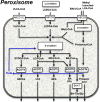Deactivating Fatty Acids: Acyl-CoA Thioesterase-Mediated Control of Lipid Metabolism
- PMID: 28385385
- PMCID: PMC5474144
- DOI: 10.1016/j.tem.2017.03.001
Deactivating Fatty Acids: Acyl-CoA Thioesterase-Mediated Control of Lipid Metabolism
Abstract
The cellular uptake of free fatty acids (FFA) is followed by esterification to coenzyme A (CoA), generating fatty acyl-CoAs that are substrates for oxidation or incorporation into complex lipids. Acyl-CoA thioesterases (ACOTs) constitute a family of enzymes that hydrolyze fatty acyl-CoAs to form FFA and CoA. Although biochemically and biophysically well characterized, the metabolic functions of these enzymes remain incompletely understood. Existing evidence suggests regulatory roles in controlling rates of peroxisomal and mitochondrial fatty acyl-CoA oxidation, as well as in the subcellular trafficking of fatty acids. Emerging data implicate ACOTs in the pathogenesis of metabolic diseases, suggesting that better understanding their pathobiology could reveal unique targets in the management of obesity, diabetes, and nonalcoholic fatty liver disease.
Keywords: energy homeostasis; fatty acyl-CoA; free fatty acid; mitochondria; peroxisomes.
Copyright © 2017 Elsevier Ltd. All rights reserved.
Conflict of interest statement
Conflict of interest: The authors have no conflict of interest.
Figures



Similar articles
-
Novel functions of acyl-CoA thioesterases and acyltransferases as auxiliary enzymes in peroxisomal lipid metabolism.Prog Lipid Res. 2008 Nov;47(6):405-21. doi: 10.1016/j.plipres.2008.05.001. Epub 2008 May 15. Prog Lipid Res. 2008. PMID: 18538142 Review.
-
Characterization of an acyl-coA thioesterase that functions as a major regulator of peroxisomal lipid metabolism.J Biol Chem. 2002 Jan 11;277(2):1128-38. doi: 10.1074/jbc.M106458200. Epub 2001 Oct 22. J Biol Chem. 2002. PMID: 11673457
-
The emerging role of acyl-CoA thioesterases and acyltransferases in regulating peroxisomal lipid metabolism.Biochim Biophys Acta. 2012 Sep;1822(9):1397-410. doi: 10.1016/j.bbadis.2012.03.009. Epub 2012 Mar 23. Biochim Biophys Acta. 2012. PMID: 22465940 Review.
-
Identification of fatty acid oxidation disorder patients with lowered acyl-CoA thioesterase activity in human skin fibroblasts.Eur J Clin Invest. 2005 Jan;35(1):38-46. doi: 10.1111/j.1365-2362.2005.01447.x. Eur J Clin Invest. 2005. PMID: 15638818
-
The identification of a succinyl-CoA thioesterase suggests a novel pathway for succinate production in peroxisomes.J Biol Chem. 2005 Nov 18;280(46):38125-32. doi: 10.1074/jbc.M508479200. Epub 2005 Aug 31. J Biol Chem. 2005. PMID: 16141203
Cited by
-
CR reprograms acetyl-CoA metabolism and induces long-chain acyl-CoA dehydrogenase and CrAT expression.Aging Cell. 2020 Nov;19(11):e13266. doi: 10.1111/acel.13266. Epub 2020 Oct 26. Aging Cell. 2020. PMID: 33105059 Free PMC article.
-
High-throughput screening identifies small molecule inhibitors of thioesterase superfamily member 1: Implications for the management of non-alcoholic fatty liver disease.Mol Metab. 2023 Dec;78:101832. doi: 10.1016/j.molmet.2023.101832. Epub 2023 Oct 30. Mol Metab. 2023. PMID: 38403978 Free PMC article.
-
Thioesterase superfamily member 2 promotes hepatic insulin resistance in the setting of glycerol-3-phosphate acyltransferase 1-induced steatosis.J Biol Chem. 2019 Feb 8;294(6):2009-2020. doi: 10.1074/jbc.RA118.005184. Epub 2018 Dec 6. J Biol Chem. 2019. PMID: 30523156 Free PMC article.
-
THEM6-mediated reprogramming of lipid metabolism supports treatment resistance in prostate cancer.EMBO Mol Med. 2022 Mar 7;14(3):e14764. doi: 10.15252/emmm.202114764. Epub 2022 Jan 11. EMBO Mol Med. 2022. PMID: 35014179 Free PMC article.
-
Proteomic analysis reveals dysregulation of peripheral blood neutrophils in patients with Multiple Sclerosis.Clin Exp Immunol. 2025 Jan 21;219(1):uxae115. doi: 10.1093/cei/uxae115. Clin Exp Immunol. 2025. PMID: 39817476 Free PMC article.
References
Publication types
MeSH terms
Substances
Grants and funding
LinkOut - more resources
Full Text Sources
Other Literature Sources

